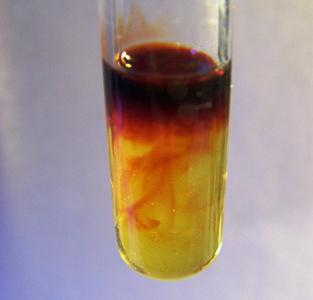Iron (III) chloride in the form of a brown solution can be prepared in the laboratory or at home. It will require heat-resistant non-metallic dishes and clean hot water (boiled or distilled). After dissolving and settling, a dark brown liquid is obtained. There are a number of features of the preparation of a solution of ferric chloride, which you should learn about before you start working with it.
Ferric chloride
Anhydrous ferric chloride produced by the chemical industry - FeCl 3 - dark brown crystals with shades of red, purple, dark green. Molar mass is 162.21 g / mol. The substance melts at a temperature of 307.5 ° C, at 500 ° C it begins to decompose. In 100 g of water, a sample of anhydrous salt is dissolved:
- 74.4 g (0 ° C);
- 99 g (25 ° C);
- 315 g (50 ° C);
- 536 g (100 ° C).
Anhydrous iron (III) chloride is a very hygroscopic substance that quickly draws moisture from the environment. In air, it interacts with water, turning into yellow crystals of hexahydrate FeCl 3 + 6H 2 O. The mass fraction of anhydrous ferric chloride in the substance acquired in the distribution network reaches 95%. A small amount of FeCl 2 and insoluble impurities are present. The trade name is Chloric Iron. The substance is fire and explosion proof, but its solution has a corrosive effect on metal objects.
Iron (III) chloride hexahydrate
In addition to anhydrous, the industry produces crystalline hydrate, in it the mass fraction of ferric chloride (III) is 60%. The substance is a yellow-brown crystalline mass or loose pieces of the same shade. An important distinguishing feature of ferrous and ferric ions is color. The oxidation state of Fe
2+ is characterized by a greenish tint, the six-water crystalline chloride of iron chloride is a bluish-green substance. In the degree of oxidation of Fe
3+ ions acquire a color from yellow to brown. For a qualitative determination of a solution of ferric chloride, reagents act:
- NaOH (a brown precipitate of Fe (OH) 3 appears);
- K 4 [Fe (CN) 6 ] (a precipitate of KFe [Fe (CN) 6 ] appears blue);
- KCNS, NaCNS (red iron thiocyanate Fe (CNS) 3 is formed).
How to dilute ferric chloride

Iron (III) chloride in the form of a solution of brown or red color can be found in the distribution network, prepared in the laboratory or at home. In the latter case, heat-resistant non-metal utensils (glass, plastic, ceramic) are required. Water for dissolving salt can be taken from the tap. Safer - boiled or distilled. Water heated to 50–70 ° C is placed in a container, and then the substance is poured in small portions. The proportions of ferric chloride and water - 1: 3. If you prepare a solution of crystalline hydrate, then less water will be required, because it is contained in crystalline hydrate (40% by weight). A little substance is added to the solution, each serving is about 5–10 g. It is not recommended to immediately pour the entire sample because of the turbulent nature of the hydration reaction. Do not use metal utensils (spoons, spatulas). The salt should completely dissolve in warm water, for which the crystals need to be mixed well with the liquid. The process of adding hydrochloric acid (1/10 of the mass of crystals) accelerates the process. After settling for several hours, sediment may appear at the bottom due to the presence in the sample and the formation of iron hydroxide during the reaction. The finished solution should be filtered with a dark brown color and stored in a tightly closed plastic container at a moderate temperature and in the absence of direct sunlight.
The use of ferric chloride in industry and utilities. Household use
Iron salts are used in many fields. Trivalent metal chloride is used to treat water, metals and paints. The substance is used in industrial organic synthesis (catalyst, oxidizing agent). The coagulating properties of the Fe 3+ ion in the treatment of municipal and industrial effluents are especially appreciated. Under the action of iron chloride, small insoluble particles of impurities stick together and precipitate. Part of the soluble contaminants that are removed at sewage treatment plants also binds. Crystalline hydrate and anhydrous salt of FeCl 3 are used in the etching of metal printing plates. Add substance to concrete to strengthen its strength.
Chemical phenomena during etching circuit boards. Security measures
A popular chemical substance for etching printed circuit boards is ferric chloride. A solution for these purposes is prepared from 0.150 kg of salt and 0.200 l of warm water. It contains ions of Fe 3+ , Cl - , and upon hydrolysis a brown compound is formed - ferric hydroxide. The process proceeds according to the scheme: FeCl 3 + 3HOH↔ Fe (OH) 3 + 3Cl - + 3H + . The disadvantage of this method is contamination of the board by-products of the reaction, which complicate further etching. Salt itself is a non-volatile substance, but in the process of interaction with water emits corrosive vapors. Work must be done outdoors or in a well-ventilated room. Contact with the skin and mucous membranes leads to irritation and can cause dermatitis. Personal protective equipment (glasses, gloves) should be used. In contact with caustic solution, rinse skin with plenty of water.